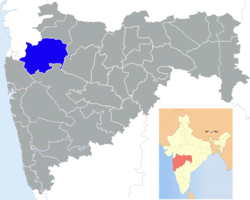Sinnar
| Sinnar सिन्नर | |
|---|---|
| city | |
 Sinnar Location in Maharashtra, India | |
| Coordinates: 19°51′N 74°00′E / 19.85°N 74.0°ECoordinates: 19°51′N 74°00′E / 19.85°N 74.0°E | |
| Country |
|
| State | Maharashtra |
| District | Nashik |
| Area | |
| • Total | 25 km2 (10 sq mi) |
| Elevation | 651 m (2,136 ft) |
| Population (2001) | |
| • Total | 65,299 |
| • Density | 2,600/km2 (6,800/sq mi) |
| Languages | |
| • Official | Marathi |
| Time zone | IST (UTC+5:30) |
| Telephone code | 02551 |
Sinnar (Marathi-सिन्नर) is a city and a municipal council in Sinnar taluka of Nashik district in the Indian state of Maharashtra.
History
At its peak, the Seuna or Yadava dynasty (850 - 1334) ruled a kingdom stretching from the Tungabhadra to the Narmada Rivers, including present-day Maharashtra, north Karnataka and parts of Madhya Pradesh. The capital was at Devagiri, now known as Daulatabad in Maharashtra. The reign of the Yadava dynasty declined after the conquest of the Daulatabad Fort by Alauddin Khilji in 1294. Further conquest by Malik Kafur, Alauddin's general, in 1312 resulted in the killing of the members of the Yadava clan ending this illustrious dynasty.
Geography
Sinnar is located at 19°51′N 74°00′E / 19.85°N 74.0°E.[1] It has an average elevation of 651.4 metres (2135 feet). Sinnar is one of the major industrial zones of Malegaon (MIDC) built around the city of Nashik which have multiple international production companies. It lies 30 km southeast of Nashik city on the Pune - Nashik Highway.
Demographics
As of 2001 India census,[2] Sinnar had a population of 65,299. Males constitute 52% of the population and females 48%. Sinnar has an average literacy rate of 71%, higher than the national average of 59.5%: male literacy is 77%, and female literacy is 64%. In Sinnar, 15% of the population is under 6 years of age.
Tourism
Tourist attractions in Sinnar include:
Gondeshwar Temple
The Gondeshwar Temple is in the Hemadpanthi style of architecture, which was popularized by Hemadri Pandit, also known as Hemadpant, a minister during the Yadav Dynasty. The most striking feature of the construction was the use of locally available black stone and lime, glorifying the local craftsmanship.The degree of skill that went into making the carved panels and the entire design of the temple is awesome.
Lying around the crumbling remains of the temple walls and the entrance gate, this stone wonder is still the largest, most complete and the best-preserved example of the mediaeval temples of the Deccan of the Indo-Aryan style. It is a Shaiva Panchayatan, or a group of five temples within a large enclosure. The central shrine is dedicated to Lord Shiva and the remaining four around it are temples to Sri Parvati, Sri Ganapati, Surya Bhagwan and Lord Vishnu. The temple is truly unique in design, perfect in proportion and the stone carvings are exquisitely beautiful.
Some sources claim that Raj Govinda of Yadava dynasty built this great temple. Yet another tradition assigns the building to Govindaraja, another Yadava king who ruled about the beginning of the twelfth century A. D.
Gargoti Museum
The Gargoti Museum houses a collection of mineral specimens native to the region. The exhibits in the museums includes specimen of diamonds, cut stones, light green cubical apophyllite, crystals of yellow calcite, blue-green aquamarine, cavansite and rare foreign minerals. These are displayed in two galleries namely 'Minerals from the Deccan Plateau' located on the first floor and 'The Prestige Gallery' on the ground floor. The museum is located 32 km from Nashik, on the Nashik-Shirdi road.
Others
- Jogeshwary and Bhairavnath temple: located in Patole village about 7 kilometres southeast of Sinnar
- Satimata-Samatdada Temple in Vadangali
- Pataleshwar Temple: located in Chas-Nalwadi, 27 km From Sinnar
- Bhojapur Dam: located near Chas, 26 km from Sinnar, built in 1972
- Biroba maharaj mandir Gulvanch
- Mhaloba maharaj mandir Dodi (BK)
- Vishramgadh or Patta Killa 45km away from sinnar near thangaon via duber gaon.
References
- ↑ Falling Rain Genomics, Inc - Sinnar
- ↑ "Census of India 2001: Data from the 2001 Census, including cities, villages and towns (Provisional)". Census Commission of India. Archived from the original on 2004-06-16. Retrieved 2008-11-01.
External links
- Sinnar- NashikDiary.com
http://www.indiatravelogue.com/leis/heri/gondeshwar.html
| Wikimedia Commons has media related to Sinnar. |
| ||||||||||||||||||||||||||||||||
